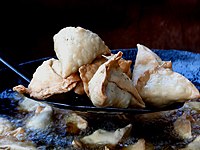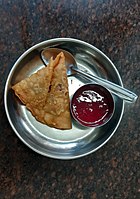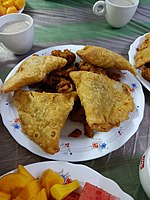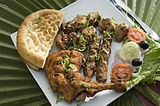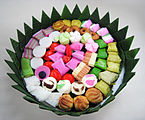サモサ
Samosa/ja
| サモサ | |
|---|---|
 チャツネを添えたサモサ | |
| 別名 | サンブーサ、サムーサ、シンガラ、シンガラ/シンガラ、サモーサ |
| 種類 | セイボリー・ペイストリー |
| フルコース | オードブル、付け合わせ、スナック菓子 |
| 地域 | 南アジア、西アジア、東アフリカ、中央アジア、東南アジア |
| 提供時温度 | 熱い |
| 主な材料 | 小麦粉、野菜(ジャガイモ、タマネギ、エンドウ豆、レンズ豆など)、香辛料、トウガラシ、挽き肉、チーズ |
サモサ (/səˈmoʊsə/) (![]() listen (help·info)) (ヒンディー語: समोसा) (ペルシア語: سمبوسه) は、揚げた南アジアおよび西アジアの軽食である。ペイストリー生地に香辛料で味付けされたジャガイモ、タマネギ、エンドウなどの野菜を詰めるのが一般的であるが、肉や魚、さらにはチーズを含む場合もある。その名称は中世ペルシア語の sambosag (سنبوسگ)(「三角形のペイストリー」の意)に由来する。地域によって三角形、円錐形、三日月形など様々な形で作られる。サモサはしばしばチャツネとともに提供され、その起源は中世あるいはそれ以前に遡る。甘いバージョンも作られる。サモサは南アジア、東南アジア、西アジア、中央アジア、ポルトガル、東アフリカおよびそれらの南アジア系ディアスポラの料理において人気のある前菜、アペタイザー、またはスナックである。
listen (help·info)) (ヒンディー語: समोसा) (ペルシア語: سمبوسه) は、揚げた南アジアおよび西アジアの軽食である。ペイストリー生地に香辛料で味付けされたジャガイモ、タマネギ、エンドウなどの野菜を詰めるのが一般的であるが、肉や魚、さらにはチーズを含む場合もある。その名称は中世ペルシア語の sambosag (سنبوسگ)(「三角形のペイストリー」の意)に由来する。地域によって三角形、円錐形、三日月形など様々な形で作られる。サモサはしばしばチャツネとともに提供され、その起源は中世あるいはそれ以前に遡る。甘いバージョンも作られる。サモサは南アジア、東南アジア、西アジア、中央アジア、ポルトガル、東アフリカおよびそれらの南アジア系ディアスポラの料理において人気のある前菜、アペタイザー、またはスナックである。
語源
英語の samosa は、ヒンスターニー語の samosa (Urdu: سموسہ, Hindi: समोसा) に由来し、さらに遡ると中世ペルシア語の sambōsag (سنبوسگ)(「三角形のペイストリー」)に行き着く。類似のペイストリーは、アラビア語ではsambusakと呼ばれ、これはペルシア語からの借用である。中世アラビア語の料理書では、sambusajと綴られる場合もあり、いずれもペルシア語の sanbosag から借用されたものである。
歴史


南アジアのサモサは、中東における焼かれたもので揚げられていない中世の原型から派生したと考えられている。サモサの原型についての最古の言及は、アッバース朝時代の詩人Ishaq al-Mawsiliによるもので、sanbusaj を称賛している。10世紀から13世紀のアラブ料理書には、sanbusak、sanbusaq、sanbusaj の名でレシピが記されており、いずれもペルシア語の sanbosag に由来する。イランでは16世紀まで広く人気があったが、20世紀までにはその人気は特定の州(ラーレスターンのsambusasなど)に限定されるようになった。Abolfazl Beyhaqi(995年–1077年)というイラン人の歴史家は、自身の著作『Tarikh-e Beyhaghi』の中でこれについて言及している。
中央アジアの サムサ は、13世紀または14世紀に中東や中央アジアから来た料理人によってインド亜大陸にもたらされた。彼らはデリー・スルターン朝の支配者の宮廷厨房で働いていた。学者でありデリー・スルターン朝の宮廷詩人であったAmir Khusro(1253年–1325年)は、1300年頃に王族や貴族が「肉、ギー、タマネギなどで作られたサモサ」を好んで食べていたと記している。14世紀の旅行家・探検家であるIbn Battutaは、Muhammad bin Tughluqの宮廷での食事について記し、そこで供された samushak または sambusak を、小さなパイで、中に刻んだ肉、アーモンド、ピスタチオ、クルミ、香辛料が詰められたものであり、これは プラオ の3品目の前に出されていたと述べている。中央インドのマールワー・スルターン朝の支配者Ghiyath Shahのために編まれた中世インドの料理書『Nimatnama-i-Nasiruddin-Shahi』にもサモサ作りの技術が記されている。16世紀のムガル帝国の文献『Ain-i-Akbari』にはコッタブのレシピが記されており、その中で「ヒンドゥスターンの人々はこれを sanbúsah と呼ぶ」としている。
サモサはその塩味の風味と便利さによって人気を得た。ポケットサイズのこの食品は、中央アジアや南アジア各地の労働者や旅行者にとって手軽に入手できる軽食であった。
地域別の種類
インド
サモサは薄力粉(現地ではマイダと呼ばれる)で作った生地に、さいの目に切って調理した、または茹でてつぶしたジャガイモ、タマネギ、グリーンピース、レンズマメ、ショウガ、香辛料、青唐辛子などを混ぜた具を詰めて作られる。具材によって、サモサは菜食の場合も非菜食の場合もある。全体をギーではなく植物油で(まれにギーで)揚げ、黄金色になるまでディープフライする。熱いうちに提供されることが多く、ミントやコリアンダーチャツネ、タマリンドチャツネなどの新鮮なグリーンチャツネと共に供されることが多い。甘いタイプに作ることも可能である。サモサはよく紅茶とともに軽食として、あるいは伝統的な付け合わせ(ヒヨコマメまたは白エンドウの料理)にヨーグルト、タマリンドチャツネ、グリーンチャツネをかけ、刻んだタマネギ、コリアンダー、チャートマサラを添えたチャート(屋台料理の一種)として提供される。
In the Indian states of Assam, Odisha, West Bengal, Bihar and Jharkhand, singaras (সিঙ্গারা) or shingras (চিংৰা) (the East Indian version of samosas) are popular snacks found almost everywhere. They are a bit smaller than in other parts of India, with a filling consisting chiefly of cooked diced potato, peanuts, and sometimes raisins. Shingras are wrapped in a thin sheet of dough (made of all-purpose flour) and fried. Good shingras are distinguished by flaky textures akin to that of a savory pie crust.
Singaras may be eaten as a tea-time snack. They can also be prepared in a sweet form. Bengali singaras tend to be triangular, filled with potato, peas, onions, diced almonds, or other vegetables, and are more heavily fried and crunchier than other singaras or their samosa cousins. Singara filled with cauliflower mixture is a popular variation. Non-vegetarian varieties of singaras are mutton singaras and fish singaras. There are also sweet versions, such as coconut singara, as well as others filled with khoya and dipped in sugar syrup that are known as Mishti Shingara.
In the city of Hyderabad, a smaller version of samosa with a thicker pastry crust and minced meat filling, referred to as lukhmi, is consumed, as is another variation with an onion filling. Crispy samosas filled with a spicy onion filling are also popular in the city and known as Irani/onion samosas. They were popularised by Irani cafes in the city and are also popularly sold in train stations and bus stands.
In the states of Andhra Pradesh, Karnataka, Kerala, and Tamil Nadu, samosas are slightly different, being folded differently, more like Portuguese chamuças, with a different style of pastry. The filling also differs, typically featuring mashed potatoes with spices, fried onions, peas, carrots, cabbage, curry leaves, and green chilis, and is mostly eaten without chutney. Samosas in South India are made in different sizes, whose fillings are influenced by local food habits, and may include meat.
-
Samosas before being fried, at a sweet shop in Kolkata.
-
Samosas in India
-
Samosa with tomato ketchup available at Indian coffee houses in Kerala
-
Vegetable samosa
-
Vegetable samosa
Both flat-shaped (triangular) and full-shaped (tetrahedron/triangular pyramid) samosas are popular snacks in Bangladesh. A Bengali version of the full-shaped samosa is called a সিঙাড়া (shingara) and is normally smaller than the standard variety. The shingara is usually filled with pieced potatoes, vegetables, nuts, etc. However, shingaras filled with beef liver are very popular in some parts of the country. The flat-shaped samosa is called a somosa or somucha, and is usually filled with onions and minced meat.
Nepal
Samosas are called singadas in the eastern part of Nepal; the rest of the country calls it samosa. In Nepal, samosa was introduced to by the Indian merchants and communities who migrated to Nepal, such as the Marwari people, and it quickly became a very popular snack. Instead of chuntey as popular in the neighbouring countries, samosa is often served and consumed with a chickpea or green pea curried soup. Vendors sell the dish in various markets and restaurants.
Pakistan
Samosas of various types are available throughout Pakistan. In general, most samosa varieties sold in the southern Sindh province and in the eastern Punjab, especially the city of Lahore, are spicier and mostly contain vegetable or potato-based fillings. However, the samosas sold in the west and north of the country mostly contain minced meat-based fillings and are comparatively less spicy. The meat samosa contains minced meat (lamb, beef, or chicken) and is popular as a snack food in Pakistan.
In Pakistan, the samosas of Karachi are famous for their spicy flavour, whereas samosas from Faisalabad are noted for being unusually large. Another distinct variety of samosa, available in Karachi, is called kaghazi samosa (Urdu: کاغذی سموسہ; "paper samosa" in English) due to its thin and crispy covering, which resembles a wonton or spring roll wrapper. Another variant, popular in Punjab, consists of samosas with side dishes of mashed spiced chickpeas, onions, and coriander leaf salad, as well as various chutneys to top the samosas. Sweet samosas are also sold in the cities of Pakistan including Peshawar; these sweet samosas contain no filling and are dipped in thick sugar syrup.
Another Pakistani snack food, popular in Punjab, is known as samosa chaat. This is a combination of a crumbled samosa, along with spiced chickpeas (channa chaat), yogurt, and chutneys. Alternatively, the samosa can be eaten on its own with chutney on the side.
In Pakistan, samosas are a staple iftar food for many Pakistani families during the month of Ramzan.
Maldives
The types and varieties of samosa made in Maldivian cuisine are known as bajiyaa. They are filled with a mixture including fish like tuna and onions.
Similar snacks
Template:More citations needed section Similar snacks and variants of samosas are found in many other countries. They are derived either from the South Asian somasa or are derived from the medieval precursor that originated in the Middle East.
Central Asia
The samsa is a savoury pastry in Central Asian cuisines, consisting of a bun stuffed with meat and sometimes vegetables.
Southeast Asia
Myanmar (Burma)

Samosas are called samuza (စမူဆာ) in Burmese, and are an extremely popular street snack in Burma. Samosas are also used in a traditional Burmese salad called samuza thoke (စမူဆာသုပ်; lit. 'samosa salad'), a salad of cut samosa pieces with onions, cabbage, fresh mint, light potato and chickpea curry broth, masala, chili powder, salt and lime.
Indonesia

In Indonesia, samosas are locally known as samosa, filled with potato, cheese, curry, rousong or noodles as adapted to local taste. They are usually served as a snack with sambal. Samosa is similar to Indonesian pastel, panada and epok-epok.
Africa
East Africa
Samosas are also a key part of East African food often seen in Somalia, Tanzania, Kenya, Uganda, Burundi, Eritrea, Ethiopia, and Rwanda. In much of East Africa, samosa is called "sambusa" (Tigrinya and Amharic: ሳምቡሳ "sāmbusā," Somali: sambuus, Swahili: sambusa, Arabic: سمبوسة "sambusa")
Samosas, locally called samoussas, are a popular snack on Réunion and Mauritius as both islands have faced large waves of labor immigration from the Indian subcontinent. The samosas there are generally smaller and filled with chicken, cheese, crabs or potatoes. There are also varieties such as chocolate and banana or pizza.
The variety of samosa made in Somali cuisine is filled with ground beef or vegetables, along with usually being blended with Somali spices. Sambusa is often consumed during Ramadan. Samosas are also a staple of local cuisine in the fellow Horn of Africa countries of Djibouti and Ethiopia.

South Africa
Called samoosas in South Africa, they tend to be smaller than Indian variants, and form part of South African Indian and Cape Malay cuisine.
West Africa
Samosas also exist in West African countries such as Ghana and Nigeria, where they are a common street food. In Nigeria, it is usually served in parties along with chicken or beef, puff puff, spring rolls and plantains and are called small chops.
Middle East
Arab countries

Sambousek (Arabic: سمبوسك) are usually filled with either meat, onion, pine nuts, za’atar, spinach dock, or cheese.
Iran

Sambuseh (Persian: سمبوسه) can often be found in the southern regions of Iran and rarely in other areas. However, traditionally it used to be made in the form of qottab filled with ground nuts (usually, walnuts), sugar, fragrant herbs or spices, and likewise fried in oil. It is used as a confectionary and quite commonly. When meat is used, it is no longer called qottab. This is all that remains of the old "sanbusag" in its ancient homeland. Nowadays, Iranian Sambuseh is often made with a sausage and pizza cheese based filling; however, a vegetable-based variety also exists.
Israel
Sambusak (Hebrew: סמבוסק) comes in several distinct forms, as sambusak has been influenced differently by Sephardic and Mizrahi cuisine. Sephardi sambusak is generally thicker, baked, and stuffed with either cheese or beef and coated with sesame or nigella seeds. Mizrahi sambusak is generally thinner, larger, fried, and stuffed with curry-spiced chickpea and onion, and is usually not coated with seeds.
Portuguese-speaking regions
In Goa (India), Portugal, and Angola, samosas are known as chamuças. They are usually filled with chicken, beef, pork, lamb or vegetables, and generally served quite hot. Samosas are an integral part of Goan and Portuguese cuisine, where they are a common snack.
-
Goan chamuças
-
Portuguese chamuças in a café in Ponta Delgada
-
Angolan chamuças
English-speaking regions
Samosas are popular in the United Kingdom, Australia, New Zealand, Trinidad and Tobago, Barbados, Guyana, Uganda, South Africa, Rwanda, Kenya and Tanzania, and are also growing in popularity in Canada and the United States. They may be called samboosa or sambusac, but in South Africa, they are often called samoosa. Frozen samosas are increasingly available from grocery stores in Australia, Canada, the United States, and the United Kingdom, where they are also frequently sold fresh by local Indian and Pakistani street market vendors.
Al-Shabaab's samosa ban
Al-Shabaab, the extremist group controlling parts of Somalia, banned samosas in 2011 over concerns about the possible use of rotten meat in the filling.
関連項目
外部リンク
| この記事は、クリエイティブ・コモンズ・表示・継承ライセンス3.0のもとで公表されたウィキペディアの項目Samosa(2 August 2025, at 05:13編集記事参照)を翻訳して二次利用しています。 |
- Pastries
- Central Asian cuisine
- Bangladeshi fast food
- Bangladeshi snack foods
- Indian snack foods
- Indonesian snack foods
- Middle Eastern cuisine
- Sephardi Jewish cuisine
- Stuffed dishes
- Kashmiri cuisine
- Burmese cuisine
- Goan cuisine
- Pakistani fast food
- Pakistani snack foods
- Indian fast food
- Somali cuisine
- Maldivian cuisine
- Malaysian cuisine
- Singaporean cuisine
- Nepalese cuisine
- Portuguese cuisine
- Cuisine of Odisha
- Iranian pastries
- South African cuisine
- Eritrean cuisine
- Ethiopian cuisine
- Kenyan cuisine
- Djiboutian cuisine
- Deep fried foods
- Tajik cuisine
- South Asian cuisine
- North Indian cuisine
- South Indian cuisine
- Dumplings
- Arab pastries
- Bangladeshi cuisine
- Pakistani cuisine
- Indo-Caribbean cuisine
- Barbadian cuisine
- Fijian cuisine
- Israeli pastries

